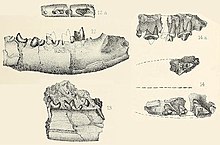This article possibly contains original research. Please improve it by verifying the claims made and adding inline citations. Statements consisting only of original research should be removed. (November 2023) (Learn how and when to remove this template message)
| Sinopidae Temporal range: Early to Middle Eocene
| |
|---|---|

| |
| Skeleton of Sinopa major | |

| |
| lower jaw of Prototomus secundarius | |
| Scientific classification | |
| Domain: | Eukaryota |
| Kingdom: | Animalia |
| Phylum: | Chordata |
| Class: | Mammalia |
| Order: | †Hyaenodonta |
| Family: | †Sinopidae Solé, 2013[1] |
| Type genus | |
| †Sinopa Leidy, 1871
| |
| Genera | |
| |
| Synonyms | |
Sinopidae ("swift foxes")[3] is an extinct family of predatory placental mammals from extinct order Hyaenodonta. Fossil remains of these mammals are known from early to middle Eocene deposits in North America, Europe and Asia.[5][6][7][8]